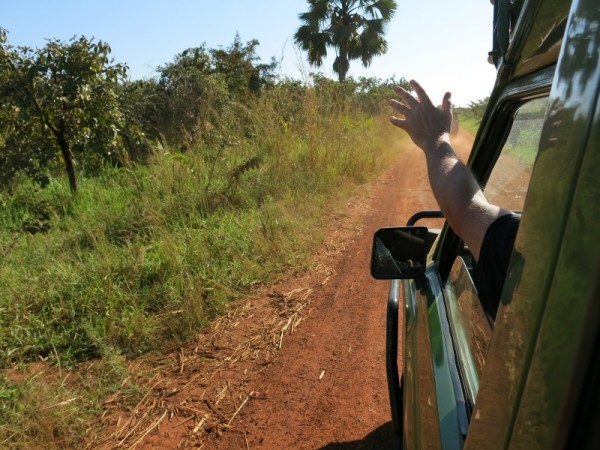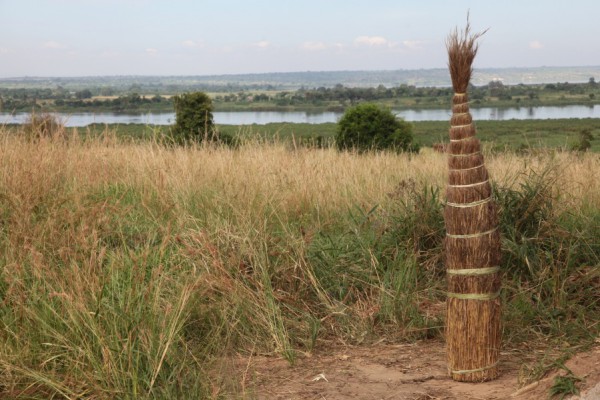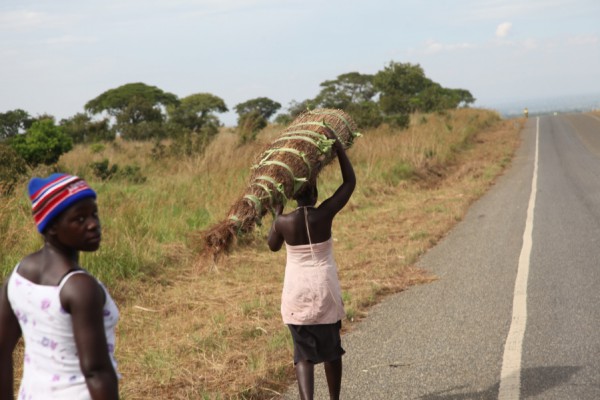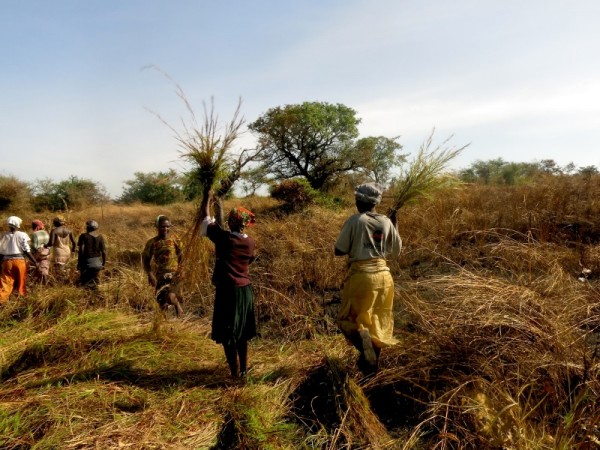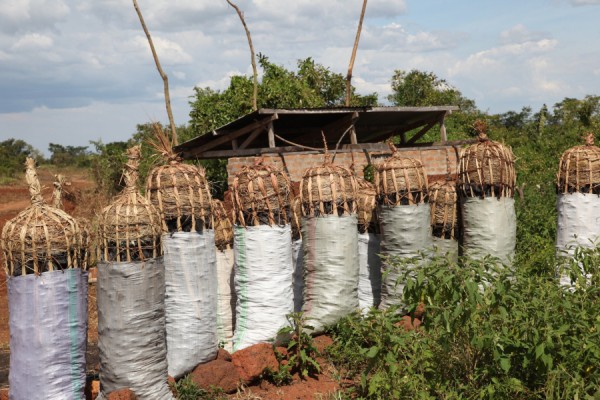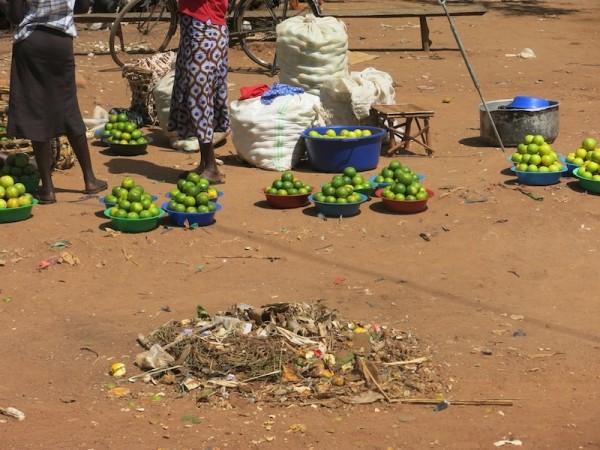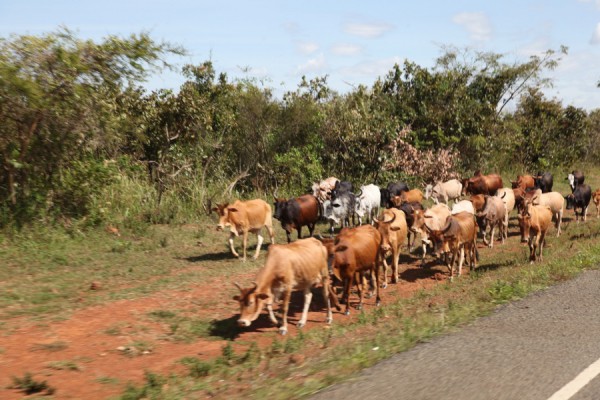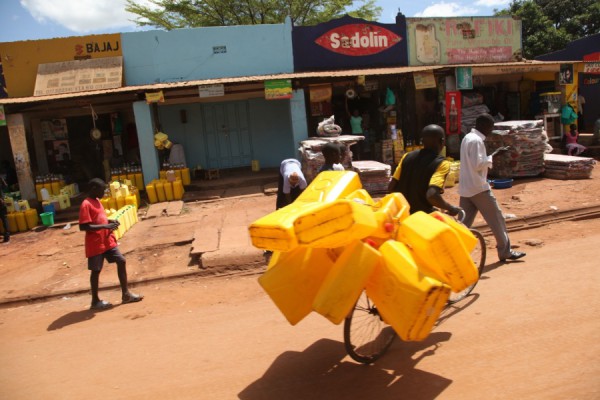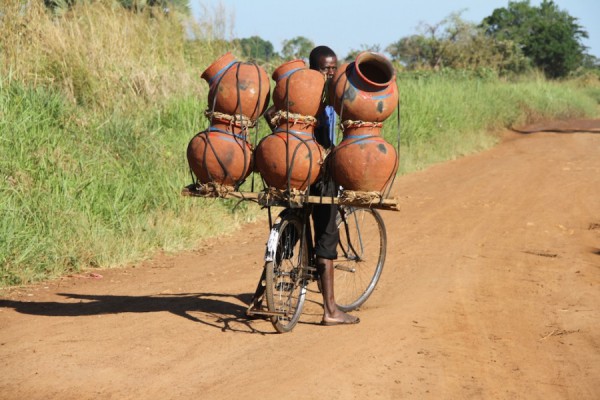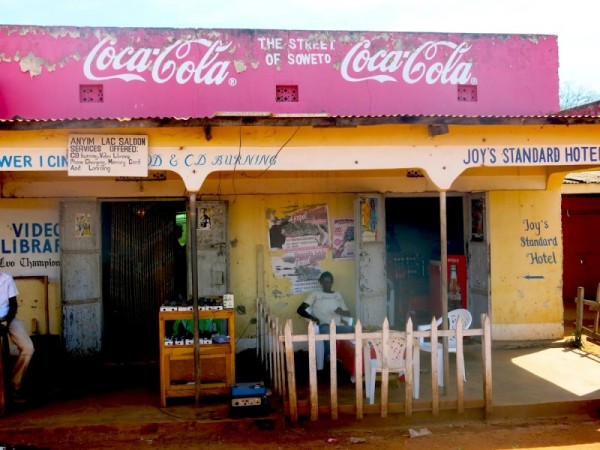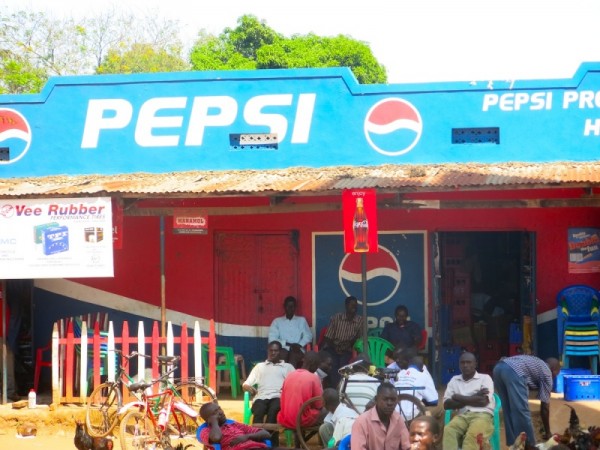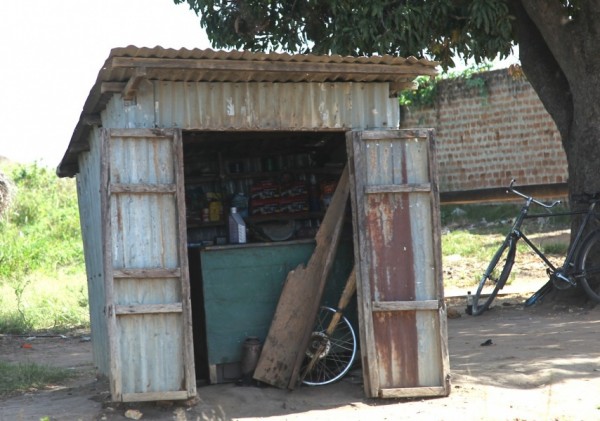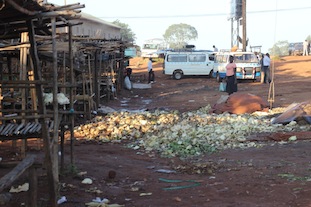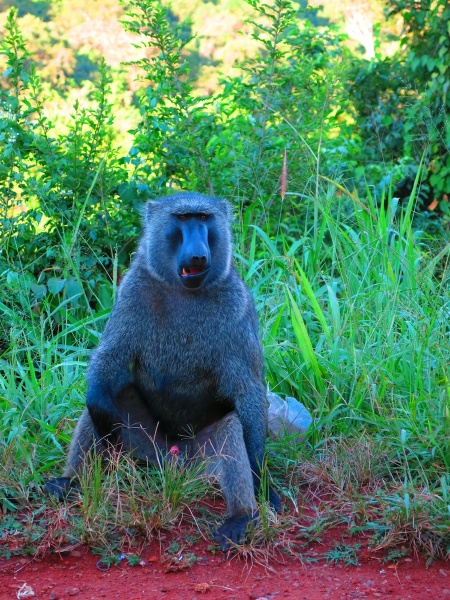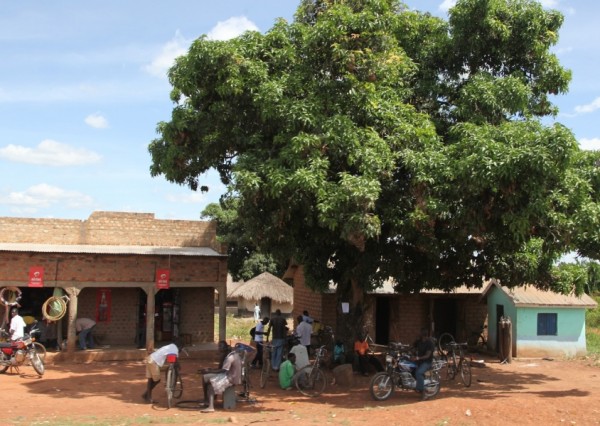Today was a travelling day to Soroti, Uganda. It gives us a chance to talk about the road scenes of Northern Uganda …
On the road
The road connects villages to their local markets and therefore is covered on either side by economic activity. There are the ‘thatch’ cutters, teams of women armed with knives and machetes cutting down the tall grasses on either side of the road. The long grasses are then laid down to dry, looking like long carpets. They are then bundled up into long packets, about 6 feet long and 18 inches thick. The bundles are tied with ropes made of other plants.
Each woman then pops one on her head and marches into the local market to sell a packet for about 2,000 Ugandan shillings ($1). By our calculation, that is a 15-30 kilometer round trip the market, giving her time to make two runs. Most of the women carry empty bottles and cans on top of the grass bundle so she can buy essentials, like cooking oil at the market. The thatched bundles are then sold at the market to businesses that are working on new thatched roofs or those needing repairs. A thatched roof lasts for between five and ten years.
Then there are the charcoal makers and sellers. The thatch ladies ensure that the roads are dotted with thatch pillars. The charcoal makers burn the charcoal and then fill five foot high white bags of charcoal that line the roads in groups of 4-5. We often mistake them for nuns walking along the road in their beautiful white dresses. The white bags are typically crowned with a grass hat to keep them dry. Near Pakwach, this is a pretty simple cover but as you approach Soroti from Lira you get quite elaborate little weaved hats.
These bags are sold for about 30,000 Ugandan shillings, but it takes days to fill one bag. In 600 kilometers of driving we have only seen them for sale – we’ve never yet seen them bought.
Then there are the brick makers. Brick making involves at least three major steps. There’s the formation of the brick, typically done near the road, mixing clay and slapping big blobs into molds. Then there is the drying, where oodles of bricks are laid out along the road. And then there’s the firing, where brick are stacked up to about fifeteen feet and then ‘sealed’ into a clay oven that is constructed around them and cooked. We see these ovens in all states of repair from being built, to the firing, to the dismantling, where the burnt clay is broken off to reveal the bricks. These are then piled high on the road to sell. Because so much is under construction and so much is under destruction, you never quite know what is a brick market, what is a building under construction and what is a building being torn down. We’re not quite sure anybody is 100% sure..
So the road becomes our DIY store, with little teams of thatched pillars, grass crowned white nuns and brick pyramids. But it is also our grocery store. If you see a big tree in the distance, you are pretty sure that you will find under it 6 or 7 ladies selling pyramids of potatoes, green oranges, etc… The fruit and vegetables complement the plethora of cows, sheep, goats and chickens found along the road, somehow connected and protected by a distant owner.
And then there are the bikes, generally falling into two categories. There’s the rideable load, where the bike is carrying simple things like doors, coffins, gates or water bottles and the bike rider is still able to pedal. Then there’s the un-rideable bike. Here the owner is more aggressive and the bike might be carrying a bed, a large gate, 3 bags of charcoal, etc.. and the rider must simply haul his load; the bike acts as a wagon or wheelbarrow.
After about 1,000 photos of various loads, we give up realizing that we can no longer be surprised by what can fit on a bike, as demonstrated by Lawrence, who met carrying 6 giants pots near Acet..
Then there’s just everything else you can carry being hauled to and from the market on the heads of strong women and very strong little kids. It is illegal we suspect for a child of three and older to walk on the road without carrying at least one water jug on his/her head. You see in the distance yellow dots and you are guaranteed to find a beautiful Ugandan child smiling beneath it. The women are altogether different, carrying baskets of nuts and spices, water jugs, charcoal, thatched bundles, etc…. This, of course, gives them a ram rod straight posture, giving them a majectic air and a very practical crown.
Before talking about the markets, let’s now talk about the middle of the road, where the vehicles are. There are two types of African roads. roads in the day. And roads in the night. Day roads are funny. Every pot hole, every large crater makes you chuckle. You can drive around them or slow down and go through them. Our Ketebul team will explain that the worse the road, the less support the locals have given to the party in power. A lot of people don’t support the party in power it seems – at least by our road test.
During the day, trucks are trucks. They lead a lot, overburdened with their cargo and the dozen or so folks hitching a ride to supplement the drivers income. Then there are the ‘taxi’s’ – in Uganda, these are the white vans with English names, ferrying folks up and down the highway. They are fun because each is covered with decidedly random words, like Gorgeous, Amen, Big Mama, Jesus Love, Go! Go!, etc… Motorbikes are everywhere, mostly on the side of the road with someone lying beneath them repairing something. In Uganda,, on most of the roads we travelled, there wasn’t a huge problem with ‘passing’ because the roads were not that crowded.
Then there are night roads. These are horrible things that will kill you. They are pitch black. They are filled with deep holes that swallow you. They are lined with bikes and motorcycles that fall from the shoulder in front of you. They have trucks zooming by you, typically with one headlight so they can pretend to be motorcycles and disguise the fact that they are mostly in your lane. Everything that could happen in life is happening on the shoulder in pitch dark only to be revealed at the last second – roadside picnics, car repairs, haggling about goats, egg selling, drunken fighting and weaving… The only light is your own head lamp, which in the darkness can only seek out objects within a 8 foot range. Your driver always hates the night road and therefore drives REALLY fast to reach out next destination.
We like day roads.
Now on to markets. Every little town is a market town. If the big consumer product giants and mobile operators have arrived, and they ALL have arrived, you are guarateneed a few Orange, OMO or Coca Cola stores – painted proudly in the colours of their sponsors.
There are three sizes of shops. The first is the cement block, typically 20 feet wide, 20 feet deep. You enter it and see things on shelves. Sometimes the block has 4 doors, each like a storage shed. Behind each door is a shop. You seldom see anything that has anything to do with the sign out front. Then there is the box. This is about twice as wide as the door. If the door is open, the shop is open. Usually five men in plastic chairs are scattred in the entrance and something is being sold. You don’t go into the box. Its contents come out by request.
Then there’s the third store – it is a little shed or lean to made from scraps of wood or just a sheet covering the ground, offering scant shade. Inventory comes in the morning and leaves at night. Everything you want is sold somewhere in one of these three types of stores. But all is random. Don’t expect Omo at the Omo stores or a mobile at the Orange store. And Lord knows what you’ll find at the drug store but it will rarely be medicine.
But this collection of Lego stores is just a backdrop, 50 feet from the road. In front of these shops is the real action. Every tenth person has a chicken to sell you and the poor creature is swung around by its feet for hours and days before being sold. Every ninth person is selling nuts or grasshoppers from a bucket or woven basket. Every seventh person is selling fruit of some type from a woven basket,. Every fifth person is sitting next to a blanket that is laid out to display their wares. You get a lot of blankets with eggs, but sometimes sunglasses, nails, electic sockets, rusty tools, clay pots, cutting boards or meal grinding tools, etc… Behind the blankets are stacks of wood, bed frames, gates and other big objects, including massive pipes. Dogs, goats and pigs are everywhere rooting in the piles of garbage left over from yesterday’s market. God help you if yesterday was cabbage day (very pungent)..
And then there’s the mud. We love Ugandan mud. It is a deep red. When the ants build their palaces,, you get big stacks of mud, like deep red sand castles. The mud of a market seeps into the base of every building, soaking its way up the walls, giving the whole town a terracotta feel. A very fine mist of red dust covers everything. When red mud merges with deep green grass, you get the amazing reds and greens we associate with all things Uganda. These are the background colours over which you splash the yellow of bananas, the blacks of clay pots, the grays of cutting boards, etc…
And now a word about the genders. Hmmm. Let’s see how to put this. We see women working for dawn to dusk, with babies tied to their backs. We see men sitting in blue plastic chairs under big trees.
Jimmy
On the road to Soroti

